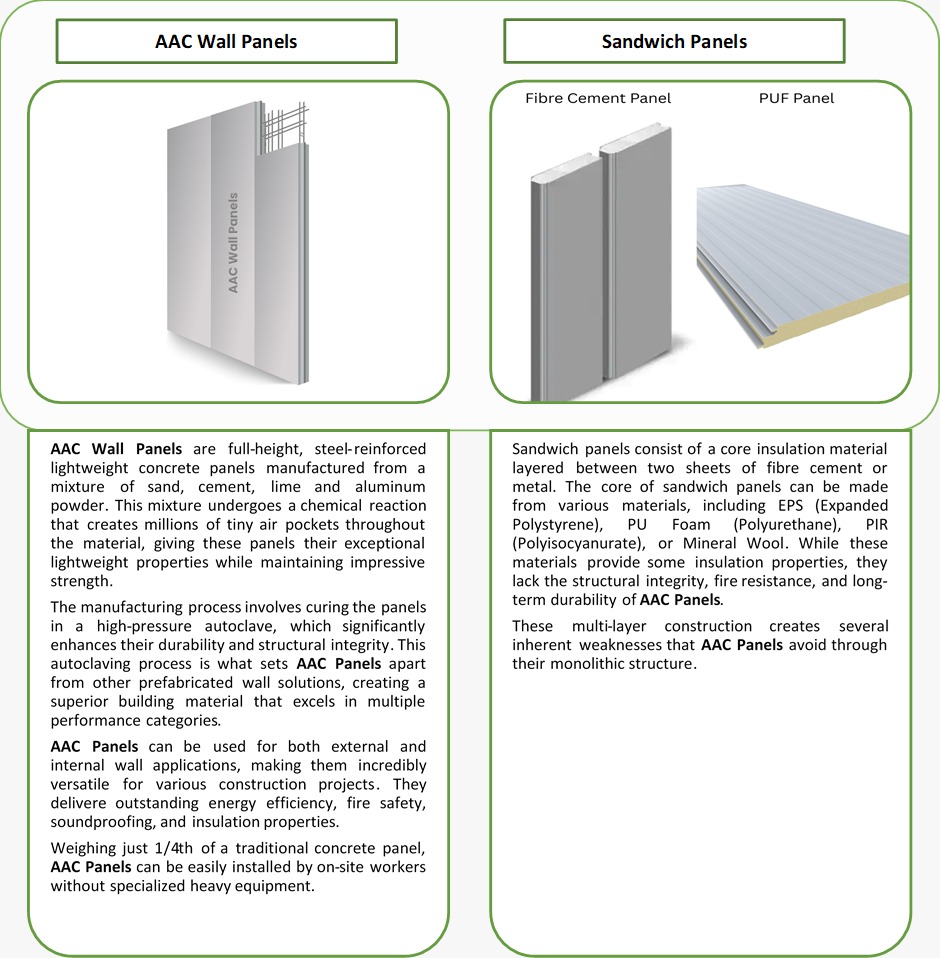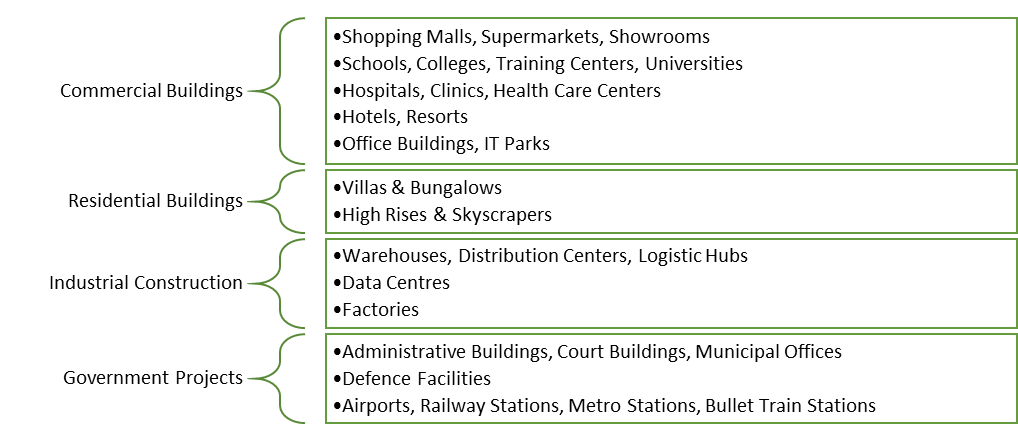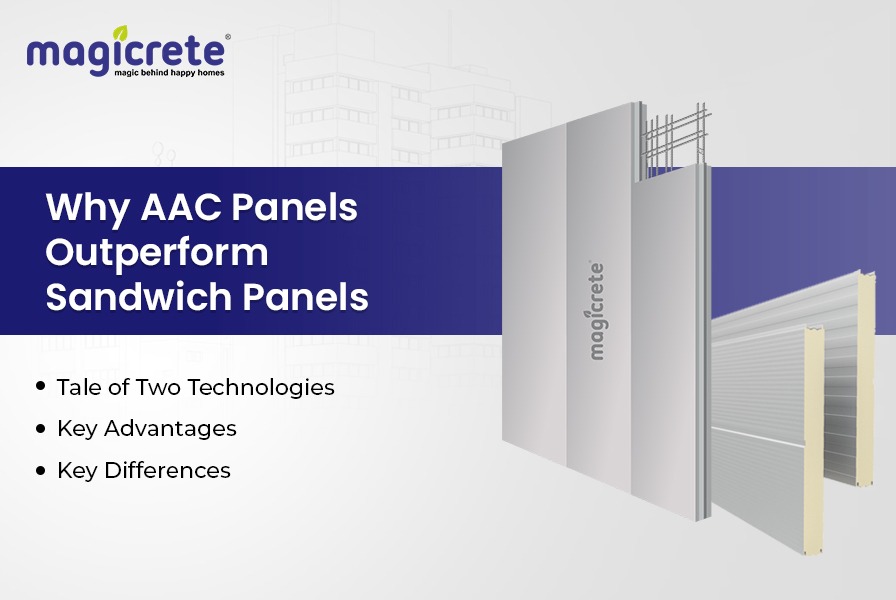Why AAC Panels Outperform Sandwich Panels
The construction industry in India is experiencing a significant shift toward innovative building materials that enhance efficiency, sustainability, and overall building performance. As technology advances, prefabricated construction techniques have emerged as the preferred choice for builders and architects seeking speed, safety, savings, and sustainability.
When it comes to prefabricated walling solutions, larger walling elements come into consideration, like AAC Panels and Sandwich Panels. While both offer advantages over traditional building materials like brick walls and RCC walls, AAC Panels clearly stand out as the superior option for modern construction projects.
This comprehensive comparison will demonstrate why AAC Panels should be your first choice for construction projects, highlighting their significant advantages over sandwich panels in terms of structural integrity, durability, fire resistance, and overall performance.
Tale of Two Technologies

Comparison of Material Properties
Parameter | AAC Wall Panels | EPS Cement Sandwich Panels | PUF Panels |
Key Components | Cement, Lime, Sand & Aeration Agent | Fibre cement sheets and EPS cement core | Steel sheets with polyurethane foam core |
Thickness Available | 75mm, 100mm, 120mm, 150mm, 200mm | 50mm, 75mm, 100mm | 50mm, 75mm, 100mm |
Dry Density | 550-650 kg/m³ | 1200-1400 kg/m³ | ~40 ± 2 kg/m³ (core) |
Compressive Strengths | 3.5 N/mm² | 0.5–1.0 N/mm² | 0.11–0.21 N/mm² |
Weight (75mm) | 55 kg/m² | 60 kg/m² | 20–25 kg/m² |
Weight (100mm) | 70 kg/m² | 80–90 kg/m² | 25–35 kg/m² |
Fire Resistance (100mm) | 4 Hours | 2 Hours | 1 Hour |
Thermal Conductivity | <0.16 W/m·K | ~0.21 W/m·K | 0.024–0.03 W/m·K |
Modulus of Elasticity | 2190 MPa | ~500–1000 MPa | ~300–400 MPa |
Sound Reduction Index (100mm) | 43 dB | 40 dB | 30-35 dB |
Impact Strength | High | High | Low |
Key Differences: AAC Wall Panels vs Sandwich Panels
When evaluating AAC wall panels vs sandwich panels, several critical differences become apparent. The following comparison highlights why Magicrete AAC Panels, built with advanced European technology, represent the smarter, future-ready choice for construction professionals.
Feature | Sandwich Panels | Magicrete AAC Wall Panels |
Structural Strength | ❌ No internal reinforcement → limited strength | ✓ Corrosion-protected steel reinforcement |
Aesthetics & Fixing | ❌ GI channels visible on surface; rust stains over time | ✓ GI L-clamps are embedded & hidden, ensuring clean finishes |
Crack Resistance | ❌ Different materials in layers → thermal expansion mismatch & cracks | ✓ Monolithic single material → No differential expansion = crack-free performance |
Fire Resistance | ❌ 2 hrs at 75 mm thickness | ✓ 3 hrs at 75 mm and 4 hrs at 100 mm thickness, per IS 3809:1979 |
Thermal Conductivity | ❌ 0.21 W/m·K | ✓ 0.16 W/m·K → Better insulation & energy efficiency |
Sound Insulation | ❌ 35 dB at 100 mm | ✓ 44 dB at 100 mm → Excellent acoustic performance |
Panel Size | ❌ Max 3 m height, up to 75 mm thickness | ✓ Available upto 6m height and thickness options of 75mm, 100mm, 120mm, 150mm and 200mm |
MEP Compatibility | ❌ Only vertical chiseling allowed | ✓ Both vertical and horizontal MEP routing, even at joints |
Construction Quality | ❌ Multi-layer bonding risks de-bonding, water ingress | ✓ Autoclaved, precision-cut, water-resistant, anti-efflorescent material |
Key Features That Make AAC Panels Superior
- Corrosion Protected Steel Reinforcement: Unlike sandwich panels that lack steel reinforcement, AAC Panels feature corrosion-protected steel reinforcement that guarantees exceptional durability and resilient performance throughout the building’s lifespan. This reinforcement provides structural integrity that sandwich panels simply cannot match.
- Lightweight Construction: AAC Panels are approximately 60% lighter than conventional concrete while maintaining high compressive strength. This lightweight design significantly reduces structural loads on the building foundation, potentially saving up to 15% in foundation costs compared to traditional materials. The reduced weight also makes AAC Panel Installation faster and more efficient.
- Thermal Insulation: The unique cellular structure of AAC Panels provides outstanding thermal insulation, resulting in up to 30% energy savings in various climate conditions. With a thermal conductivity value of less than 0.16 W/m·K (compared to 0.21 W/m·K for sandwich panels), AAC Panels keep buildings cooler in summer and warmer in winter, significantly reducing heating and cooling costs over the building’s lifetime.
- Fire Resistant Wall Panels: One of the most critical advantages of AAC Panels over sandwich panels is their exceptional fire resistance. AAC Panels have a unique cellular structure that provides an outstanding 4-hour fire rating at just 100mm thickness, compared to only 2 hours for sandwich panels of 75mm thickness. With a melting point exceeding 1600 degrees Celsius, AAC Panels offer unparalleled fire safety for occupants and property.
Thickness | Fire Rating |
75 mm | 3 hours |
100 mm | 4 hours |
120 mm | 5 hours |
150 mm | 6 hours |
200 mm | 8 hours |
- Construction Speed: AAC Panel Installation reduces project timelines dramatically, delivering 4x faster construction compared to AAC blocks. A single AAC Panel replaces approximately 15 AAC blocks, covering more area in less time. Installation requires just 1 mason and 2 helpers to install 50 m²/day, compared to 35 m²/day for AAC blocks and a mere 10 m²/day for traditional red clay bricks.
- Structural Stability: AAC Panels provide exceptional structural stability for wall heights up to 6 meters without requiring coping or bond beams. This eliminates the need for additional reinforcement, resulting in quicker construction, reduced material usage, and significant labour cost savings. Sandwich panels, by contrast, are typically limited to 3 meters in height and lack this inherent structural integrity.
- Sustainable Building Materials: As GRIHA-listed Sustainable Building Materials, AAC Panels represent an environmentally responsible choice. Their lightweight and fully recyclable design, combined with low embodied energy, significantly reduces a building’s carbon footprint from the outset. The environmental impact of AAC Panels is substantially lower than that of sandwich panels, making them the preferred choice for green building projects.
Key Advantages of AAC Panels Over Alternatives
Parameter | AAC Wall Panels | Hollow Core Wall Panels | Red Bricks |
Key Components | Cement, Lime, Sand & Aeration Agent | Cement, Sand, Stone aggregates | Top Soil |
Thickness Available | 75mm, 100mm, 120mm, 150mm, 200mm | 75mm, 92mm, 120mm | 100mm |
Dry Density | 550-650 kg/m³ | ~1400 kg/m³ | 1950 kg/m3 |
Weight (75mm) | 55 kg/m² | 120 kg/m² | ~170–190 kg/m² |
Weight (100mm) | 70 kg/m² | 190 kg/m² (120mm) | ~220–250 kg/m² |
Fire Resistance (100mm) | 4 Hours | 2 Hours | 1.5 Hours |
Thermal Conductivity | <0.16 W/m·K | 0.4 W/m·K | 1.0 W/m·K |
Modulus of Elasticity | 2190 MPa | ~8000–12000 MPa | ~3,000 – 5,000 Mpa |
Impact Strength | High | Low | Low |
- Cost of AAC Panels: While the initial Cost of AAC Panels may be comparable to alternatives, the long-term economic benefits are substantial. AAC Panels deliver up to 15% savings in foundation costs due to their lightweight nature. Additionally, their superior thermal properties can reduce energy consumption by approximately 30%, resulting in significant operational cost savings throughout the building’s lifecycle.
- AAC Panel Installation: The AAC Panel Installation process is remarkably efficient, requiring just 1 mason and 2 helpers to install 50 m²/day. This is significantly faster than traditional methods, with AAC blocks achieving only 35 m²/day and red clay bricks a mere 10 m²/day. The simplified installation process reduces labour costs and accelerates project timelines.
- Sound Insulation Wall Panels: AAC Panels provide exceptional sound insulation, with a sound reduction index exceeding 40 dB with just a 3-4 mm skim coat. For enhanced acoustic performance, installing 12.5mm gypsum board with stud framing on both sides can achieve an impressive STC rating of 52 dB. This makes AAC Panels ideal for applications where noise reduction is critical, such as residential buildings, hotels, and commercial spaces.
Thickness | STC Rating |
75 mm | 40 dB |
100 mm | 43 dB |
120 mm | 44 dB |
150 mm | 46 dB |
200 mm | 48 dB |
- Space Efficiency: AAC Panels offer significant space-saving advantages. By utilizing 75mm internal walls instead of standard 100mm walls, approximately 2% of floor space can be reclaimed. This space efficiency is particularly valuable in urban developments where maximizing usable area is essential.
- Versatility and Customization: AAC Panels are remarkably versatile and easy to customize. They can be readily chiselled, cut, and cored as required, allowing for simple modifications during installation. This adaptability makes AAC Panels suitable for a wide range of applications and architectural designs.
Application Areas: Where AAC Panels Excel
AAC Panels demonstrate exceptional versatility across numerous construction applications, regardless of climate or project location:
Internal & External Walls

When to Consider Sandwich Panels
While AAC Panels are clearly superior for permanent structures and quality construction, sandwich panels may be considered for:
- Temporary or semi-permanent structures
- Projects where installation speed is the only priority, with less concern for long-term durability, fire safety, or structural integrity
- Applications where the limited performance of sandwich panels is acceptable for the intended use
However, for any project where quality, durability, safety, and long-term performance are priorities, AAC Panels represent the clearly superior choice.
AAC Panels - The Clear Choice for Modern Construction
The comparison between AAC Panels and sandwich panels reveals a clear winner for construction professionals seeking quality, performance, and value. AAC Panels offer significant advantages through their monolithic structure, which provides greater structural stability and long-term strength compared to the multi-layer construction of sandwich panels that can lead to delamination, seasonal expansion, contraction, and cracks over time.
For builders and architects prioritizing strength, sustainability, and performance at competitive prices, AAC Panels deliver superior value across all critical metrics. They support green building standards, dramatically reduce construction time, save energy throughout the building’s lifecycle, and provide exceptional durability for decades of reliable service.
Magicrete AAC Wall Panels represent the next evolution in wall construction technology. Built with advanced engineering, these lightweight, steel-reinforced wall panels deliver improved energy efficiency, enhanced fire and earthquake resistance, and superior insulation properties compared to any alternative.
As India’s leading AAC wall panel manufacturer, Magicrete is committed to providing construction professionals with the highest quality building materials that combine performance, sustainability, and value. Contact us today to discover how our durable, fire-resistant, soundproof, and eco-friendly AAC Panels can elevate your next construction project to new heights of excellence.
Content
- Why AAC Panels Outperform Sandwich Panels
- Tale of Two Technologies
- Comparison of Material Properties
- Key Differences: AAC Wall Panels vs Sandwich Panels
- Key Features That Make AAC Panels Superior
- Key Advantages of AAC Panels Over Alternatives
- Application Areas: Where AAC Panels Excel
- When to Consider Sandwich Panels
- AAC Panels - The Clear Choice for Modern Construction



